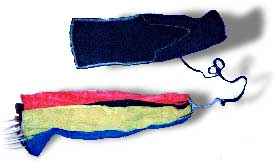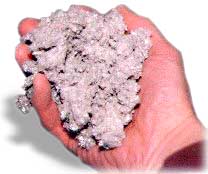The parachute needs to be protected from the ejection charge, or the hot gases and particles can melt it. Several techniques have been used successfully including deployment bag, wadding, piston, baffle and canister.
Deployment Bag

A deployment bag is a bag into which the parachute is stuffed. Deployment bags are often made of a fire resistant material like Nomex cloth to prevent a nylon parachute from being melted by the ejection charge. A deployment bag also servers the additional purpose of orderly deployment.

Wadding

Wadding is a fire resistant material, like cellulose insulation, that is placed between the ejection charge and parachute. Cellulose insulation is chopped newspapers treated to be fire resistant. The material needs to be biodegradeable.
Piston
A piston is literally a piston, perhaps made from a cardboard tube coupler with plywood end caps, that is located between the ejection charge and parachute. The piston prevents the ejection gases from reaching the parachute. The ejection gases cause the piston to move, which usually pushes the nosecone off and the parachute out.
Baffle
A baffle is used to filter and redirect ejection gasses so that they do not directly impact the parachute. Several baffle designs have been used. A simple design consists of two disks with holes. The disks are aligned so that the holes are not aligned. Hot particles that might melt the parachute are stopped when they hit the disks.
Canister
A canister can be a cardboard tube with a cap on the end facing the ejection charge. When the airframe is pressurized the nosecone is ejected, pulling the parachute from the canister. A small “pilot” parachute may be used to help pull the main parachute out of the canister. This technique can be used when the airframe contains sufficient space to house a canister.
Multiple protection techniques can be combined, too. For example a deployment bag can be used with a piston and canister system to also provide for orderly deployment.
Submitted by: Dean A. Roth